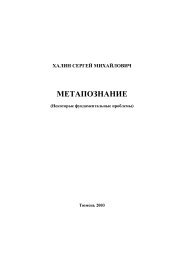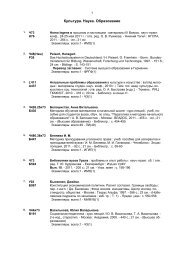The Economic History of Byzantium - Dumbarton Oaks
The Economic History of Byzantium - Dumbarton Oaks
The Economic History of Byzantium - Dumbarton Oaks
Create successful ePaper yourself
Turn your PDF publications into a flip-book with our unique Google optimized e-Paper software.
1006 NICOLAS OIKONOMIDES<br />
That was the situation to the time <strong>of</strong> Basil II. He attempted to increase the assets <strong>of</strong><br />
the state, introducing a new policy that was to remain in force until the end <strong>of</strong> the<br />
Byzantine Empire. <strong>The</strong> state now tended to retain and work directly any productive<br />
land that happened to come into its possession, whether as a klasma or in some other<br />
way. In other words, until the tenth century the state sought to pass land on to its<br />
subjects in order to collect the tax on it, whereas after that time it retained the land<br />
and attempted to exploit it directly by leasing it to paroikoi. Under the new method,<br />
there was undoubtedly an increase in the assets <strong>of</strong> the state, but the composition <strong>of</strong><br />
society in rural areas changed substantially as the number <strong>of</strong> dependent villagers ( paroikoi)<br />
rose. In other words, there was a tendency for the economic benefits <strong>of</strong> the state<br />
to be maximized to the detriment <strong>of</strong> the social structure <strong>of</strong> the provinces, as the state<br />
turned to implementation <strong>of</strong> the same policy as that which the dynatoi, the large landowners,<br />
were also applying. 84<br />
In practical terms, it is impossible to draw a clear dividing line between the land<br />
assets <strong>of</strong> the state and those <strong>of</strong> the crown. <strong>The</strong>re is a general impression that the crown’s<br />
property consisted largely <strong>of</strong> properly organized estates, whereas the state tended to<br />
own scattered pieces <strong>of</strong> land, <strong>of</strong>ten within village communities. <strong>The</strong>re are, however,<br />
numerous exceptions to this general distinction, whose roots usually lie in the history<br />
<strong>of</strong> the land. <strong>The</strong> principal characteristic was that the state demanded the payment at<br />
least <strong>of</strong> tax on the land that belonged to it, while the crown’senterprises collected rent<br />
(and, <strong>of</strong> course, did not pay tax to the state). In 1044, for instance, the klasma <strong>of</strong> Eucheia<br />
was the object <strong>of</strong> a dispute between the state and the kouratorikion <strong>of</strong> Mangana,<br />
with the former demanding the payment <strong>of</strong> tax and the latter <strong>of</strong> a pakton. When the<br />
estate was granted to Nea Mone on Chios, the pakton <strong>of</strong> the kouratorikion was abolished,<br />
since the land was now owned by the monastery, which, however, continued to pay tax<br />
to the state. 85<br />
Exploitation <strong>of</strong> the scattered pieces <strong>of</strong> land that came into the possession <strong>of</strong> the state<br />
always took the form <strong>of</strong> leasing, usually with the collection by state <strong>of</strong>ficials <strong>of</strong> a pakton<br />
from such neighbors as might be interested. In the case <strong>of</strong>estates, however, such as<br />
the episkepsis <strong>of</strong> Alopekai in 1073, the land was worked partly directly, by slaves and<br />
animals belonging to the estate, and partly by leasing to villagers who owned smallholdings<br />
in the area and who thus became the paroikoi <strong>of</strong> the estate. This system (that<br />
<strong>of</strong> paktosis) seems to have prevailed, ultimately, because it was more pr<strong>of</strong>itable in that<br />
it required less investment and <strong>of</strong>fered no risks. However things may have been, the<br />
management <strong>of</strong> these episkepseis was also open to entrepreneurs, who were entitled to<br />
lease them but <strong>of</strong>ten ran into difficulty with the local aristocracy. 86 <strong>The</strong> crown estates<br />
yielded revenue in cash and in kind.<br />
Over and above the land traditionally owned by the crown, kouratoreiai and episkepseis<br />
84 Cf. Lefort, “Rural Economy,” 281ff, 287ff.<br />
85 Zepos, Jus, 1:616, 617.<br />
86 M. Kaplan, Les hommes et la terre à Byzance du VIe au XIe siècle: Propriété et exploitation du sol (Paris,<br />
1992), 323.








